
Ausstellung der Dolomitenfreunde zum Jubiläum
Mostra degli Amici delle Dolomiti al giubileo
Exhibition of the Friends of the Dolomites for the jubilee


Ausstellung der Dolomitenfreunde zum Jubiläum
Mostra degli Amici delle Dolomiti al giubileo
Exhibition of the Friends of the Dolomites for the jubilee




Der 1. WK hinterließ entlang der hochalpinen Front zahlreiche Wege zu den Höhenstellungen. Durch den Zeitablauf verfielen diese und wurden unbegehbar.
Prof. Walther Schaumann, der seit Jahren in diesen Bergen unterwegs war, hatte 1972 die Idee, mit Hilfe von internationalen Freiwilligen alte Frontsteige als „Wege der Begegnung“ wieder instandzusetzen. Im Herbst versuchte er durch Aufrufe in internationalen Alpinzeitschriften Freiwillige für diese Arbeit nur gegen Unterkunft und Verpflegung zu finden. Und hatte damit Erfolg, es meldeten sich sofort viele Helfer.

MG-Nase Rundumstellung.
MG-Nase – Naso delle mitragliatrici, postazione circolare.
MG-Nase Rundumstellung (“Machine-gun nose all-round position”).

Durante la prima guerra mondiale, lungo il fronte alpino vennero tracciate moltissime vie per raggiungere le postazioni anche sulle vette più alte. Col passare del tempo questi percorsi iniziarono a deteriorarsi, a cadere in rovina e lentamente diventarono impraticabili.
Il prof. Walther Schaumann, che per lunghi anni percorse e perlustrò queste montagne, nel 1972 ebbe l‘idea di ripristinare, con l‘aiuto di volontari internazionali, le vecchie vie del fronte per trasformarle in „Vie di incontro“. In autunno fece pubblicare su numerose riviste internazionali di montagna un appello alla ricerca di volontari per questo lavoro, in cambio solo di vitto e alloggio. E ebbe immediatamente successo, subito si presentarono molti entusiasti.





World War1 left numerous trails leading up to the mountain-top positions along the high alpine front. In the course of time these paths deteriorated and became impassable.
Prof. Walther Schaumann had been a keen hiker and climber in these mountains for many years. In 1972 he had the idea to restore these former wartime trails with the help of international volunteers as a venue to “meet and encounter others”. In the autumn he appealed for assistance in various international alpine magazines. He was merely able to offer room and board for those that chose to participate and lend a hand in the work. He met with great success as he immediately received offers of help.
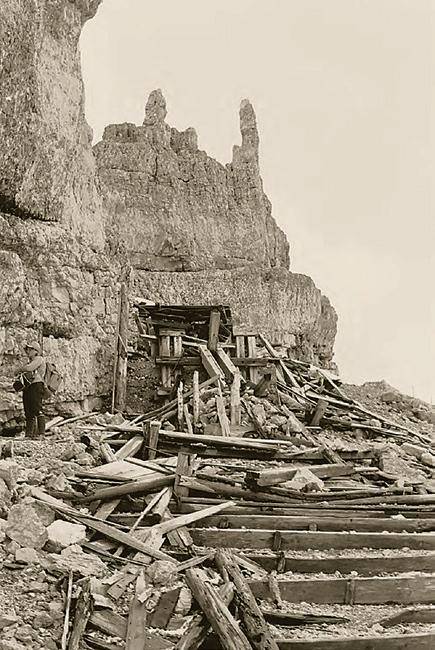





1973 stand die Revitalisierung des Weges auf den Monte Vallon Bianco in der Fanesgruppe auf dem Programm. Fahrzeuge und Maschinen wurden von der Industrie leihweise zur Verfügung gestellt. Schaumanns Buchhonorare ergaben das Aktionsbudget.
Per il 1973 era in programma il ripristino delle vie per il Monte Vallon Bianco, nel gruppo dell’Alpe di Fanes. Autoveicoli e macchinari furono messi a disposizione gratuitamente dalle ditte produttrici, per il sostegno economico della campagna vennero utilizzati i diritti d‘autore di Schaumann.


Als Dank für die Lebensrettung eines italienischen Soldaten erhielt Schaumann die Alpinikaserne am Limojoch als kostenloses Quartier für seine Freiwilligen. Ringraziamento per aver salvato la vita a un soldato italiano, la casermetta degli alpini sul passo Limo venne concessa gratuitamente a Schaumann come rifugio per i suoi volontari. In gratitude for having helped save the life of an Italian soldier, the Alpini-barracks at the Limojoch were made available to Prof. Schaumann as shelter for the volunteers free of charge.
In 1973 the primary objective was the revitalization of the Monte Vallon Bianco trail in the Fanes Region. Vehicles and machinery were provided free of charge by various participating businesses and industries. The income from Prof. Schaumann’s books provided the money to fund this undertaking.











Im Sommer 1973 berichteten bereits italienische Zeitungen über diese Aktion. Und als ein italienischer Journalist fragte „Was machen Sie als österreichischer Berufsoffizier eigentlich in Südtirol?“ antwortete Frau Schaumann spontan „Wir bauen die Via della Pace - die Friedenswege“. Und damit war dieser heute bekannte Begriff geboren.

Nell‘estate del 1973 i giornali italiani trattarono diffusamente di questa iniziativa. E quando un giornalista italiano chiese “Cosa fa esattamente un ufficiale di carriera austriaco in Alto Adige?” La signora Schaumann rispose di getto “Noi costruiamo le Friedenswege, le Vie della Pace”. Nacque così questo motto, conosciuto ancora oggi.

Der wieder hergestellte Weg auf den Monte Vallon Bianco, jetzt „Friedensweg“, daneben eine Aufnahme aus dem Jahr 1916. Il sentiero ripristinato sul Monte Vallon Bianco ora “Via della Pace”, a fianco un‘immagine del 1916. The reconstructed trail up Monte Vallon Bianco, now a „Path of Peace“, next to a photograph from the year 1916.



Da Schaumann durch seine Vorträge in Italien viele gute Bekannte bei den Alpini hatte, wurde bereits die erste Aktion durch die italienische Armee logistisch unterstützt. Dato che Schaumann per le sue opere era ben conosciuto tra gli Alpini, la prima azione di lavoro fu appoggiata logisticamente dall‘esercito italiano. As a result of his many past presentations in Italy, Prof. Schaumann had numerous acquaintances and connections within the Alpini which resulted in considerable logistical support from the Italian Army in the first action.


Zeitungsberichte im In- und Ausland förderten den Bekanntheitsgrad der „Friedenswege - Vie della pace“. Servizi giornalistici in Italia e all‘estero fecero conoscere sempre più le “Friedenswege - Vie della Pace”. National and international newspaper articles promoting and raising awareness for the „Paths of Peace – Via della Pace“.
In the summer of 1973 Italian newspapers were reporting about the group’s activity. At one point an Italian journalist asked Mrs. Schaumann „What is an Austrian officer actually doing here in Italian South Tyrol?“ Her spontaneous reply was “We are building the Via della Pace - The Paths of Peace“. That was the birth of this term which is widely recognized today.

Oberstleutnant Schaumann übergab bei der Abschlussfeier der ersten Aktion im September 1973 das neue Biwak „Cap. Baccon/Hptm Baborka“ auf der Furcia Rossa der Associazione Nazionale Alpini und den fertiggestellten Sektor der Via della pace in die Obhut der Brigata „Tridentina“. Nel settembre del 1973, durante la cerimonia di chiusura della prima azione di lavoro, il tenente colonnello Schaumann consegnò il nuovo bivacco costruito sulla Furcia Rossa e intitolato „Cap. Baccon/Hptm Baborka”, all’Associazione Nazionale Alpini e affidò la Via della Pace appena ultimata alla tutela della Brigata alpina “Tridentina”.
At the end of the first campaign in Sept. 1973 Lt. Col. Schaumann presented the new bivouac „Cap. Baccon/Hptm Baborka“ on the Furcia Rossa to the Associazione Nazionale Alpini and the completed sector of the Via della pace to the care of the Brigata“Tridentina“.

General Nerio Bianchi, der Kommandant der Alpini-Brigade „Tridentina“ betonte bei seiner Ansprache die vorbildliche und erfolgreiche Zusammenarbeit bei der Aktion „Via della pace“ als ein Symbol für die Idee eines künftigen Vereinten Europas. Durante il suo discorso il generale Nerio Bianchi, comandante la Brigata alpina“ Tridentina”, sottolineò come l‘esemplare lavoro in comune dell‘iniziativa della „Via della Pace“, coronato da successo, fosse un simbolo per la futura unità dell’Europa. In his opening speech General Nerio Bianchi, the commander of the Alpini Brigade „Tridentina“, emphasized the exemplary and successful cooperation during the action „Via della Pace“ as a symbol for the concept of a future United Europe.

Um die Tätigkeiten weiterzuführen, wurde im Herbst 1973 der Verein „Dolomitenfreunde“ gegründet. Per continuare nell’azione di lavoro, nell‘ autunno del 1973 fu fondata l‘associazione „Dolomitenfreunde – Amici delle Dolomiti“. To facilitate a continuation of its activities, the „Association of the Friends of the Dolomites“ was founded in the autumn of 1973.





Noch im Herbst 1973 wurde mit der Zentrale der Associazione Nazionale Alpini (A.N.A.) in Mailand eine Vereinbarung zur Zusammenarbeit auf den „Friedenswegen“ getroffen. 1974 arbeiteten daher viele ehemalige Alpini Seite an Seite mit unseren Freiwilligen.
A Milano, nell’autunno del 1973, presso il comitato centrale dell’Associazione Nazionale Alpini (ANA) si strinse un accordo di collaborazione nell’ambito delle “Vie della Pace”. Nel 1974 molti alpini in congedo lavorarono a fianco dei nostri volontari.

Hubschrauber der italienischen Armee flogen für die „Friedenswege“.
Elicotteri dell’esercito italiano in volo per le “Vie della Pace”. Helicopters of the Italian Army flying for the „Paths of Peace“.

Construction site – a cavern at Monte Vallon Bianco. The team consisting of a French woman and 3 Italians, excavating a tunnel.

Lebensmittelvorrat im Basislager für die freiwilligen Helfer aus dem Bestand der italienischen Armee.
Rifornimenti di viveri dell’esercito italiano per volontari nel deposito del campo base.
Provisions-depot at the base camp for the volunteers courtesy of the Italian Army.

Pioniere der Brigade „Tridentina“ setzen Bohrlöcher, um einen Wendeplatz für den PUCH-Haflinger auszusprengen.
Genieri della Brigata “Tridentina” praticano fori di mina nella roccia per creare una piazzola di svolta per il PUCH-Haflinger.
Sappers of the Brigade „Tridentina“ setting blasting charges to create a turning area for the PUCH-Haflinger.
Still in the autumn of 1973 arrangements for future collaboration on the „Paths of Peace“ were made with the Associazione Nazionale Alpini (A.N.A. or National Alpini Association) at their Milan headquarters. As a result beginning in 1974 many former Alpini were working side by side with our volunteers.


Trotz der vielen weiteren Baustellen konnten die Arbeiten an den Weganlagen am Fanes-Kamm mit noch verstärktem Einsatz fortgesetzt werden. Nonostante i molti cantieri aperti, i lavori di ripristino dei sentieri sulla dorsale del Fanes proseguirono con ancora maggior impegno. In spite of the numerous reconstruction sites along the Fanes Ridge, work could carry on with concentrated employment along the entire stretch.

An den Wochenenden gab es für die Helfer Rundfahrten mit historischen Vorträgen durch Oberstleutnant Schaumann.
Durante i fine settimana il tenente colonnello Schaumann conduceva i volontari in escursioni storiche nella zona.
On weekends the volunteers were treated to historical tours and presentations of the former front line by Lt. Colonel Schaumann.

Auch im Hochsommer kann es im Gebirge kräftig schneien.
Anche in piena estate può nevicare in alta montagna.
Even at the height of summer the mountains could be cloaked with heavy loads of snow.





Bei der Aktion 1975, an der Männer und Frauen aus acht Nationen teilnahmen, konnte auch das Biwak „Della Pace“ am Fuß des Monte Castello fertiggestellt werden.
Durante l’azione di lavoro 1975, alla quale parteciparono uomini e donne di otto nazioni venne ultimato anche il bivacco “Della Pace” ai piedi del monte Castello.

vom Limojoch
die Furcia-Rossa-Spitzen,
During the 1975 action, men and women from 8 nations participated and constructed the bivouac „Della Pace“ – „Of Peace“ at the foot of Monte Castello.











1945 wurde ein Teil der Hütten am Karnischen Kamm zerstört. Dadurch fehlten den Bergsteigern Unterkünfte, der Weg vereinsamte und verfiel. Prof. Schaumann schlug dem Hauptausschuss des ÖAV in Innsbruck eine Zusammenarbeit vor, um den Karnischen Höhenweg wieder durchgehend begehbar zu machen und fehlende Schutzhütten wieder zu errichten. Der ÖAV sicherte die Finanzierung, die maschinelle Ausrüstung, Geländefahrzeuge und die Arbeitskraft der Freiwilligen stellten die Dolomitenfreunde.

Nach über 30 Jahren ist der Karnische Höhenweg von Sillian bis zum Nassfeld wieder begehbar. Die internationale Arbeitsgemeinschaft setzte sich u.a. aus Angehörigen des Italienischen und Slowenischen Alpenclubs, der A.N.A., des Alpenvereins und der Naturfreunde Internationale zusammen.
Dopo oltre trent’anni la Traversata Carnica è ora nuovamente percorribile da Sillian fino al Passo Pramollo. La squadra di lavoro internazionale era composta da soci dei Club Alpino Italiano e Sloveno, dell’A.N.A., dell’Alpenverein e dei Naturfreunde – Amici della Natura.
After nearly 30 years the Carnic High-Alpine Ridge Trail from Sillian to Nassfeld was once again walkable. The international team consisted of members from the Italian-, Slovenian-, Austrian- and German-Alpine Clubs, and the A.N.A. and the Assoc. of Nature-friends International among others.

1976 fand die Einweihung des neuen Rathauses in Kötschach gleichzeitig mit der Wiedereröffnung des Karnischen Höhenweges statt; unter den Gästen auch hochrangige Militärpersonen aus Italien Nel 1976 venne inaugurato il nuovo municipio di Kötschach in contemporanea con la riapertura della Traversata Carnica, tra gli ospiti anche alti ufficiali italiani. The opening ceremony of the new town hall in 1976 coincided with the celebration marking the re-opening of the Carnic High-Alpine Ridge Trail. Among the distinguished guests there were also high-ranking members of the Italian Armed Forces.
Nel 1945 una gran parte dei rifugi sulla dorsale carnica venne distrutta. Gli escursionisti si trovarono così senza punti d’appoggio, l’itinerario venne abbandonato e iniziò a deteriorarsi. Il professor Schaumann propose al comitato centrale dell’ÖAV, il Club Alpino Austriaco, a Innsbruck, un lavoro in collaborazione per ripristinare il percorso della Traversata Carnica e per ricostruire i rifugi distrutti. L’ÖAV assicurò l’impegno finanziario, gli Amici delle Dolomiti le attrezzature tecniche, i veicoli fuoristrada e la forza lavoro.

Die
In 1945 a number of huts along the Carnic Ridge were destroyed. This deprived mountain climbers of any shelter; paths fell into disrepair and were abandoned. Prof. Schaumann suggested a joint collaboration to the administration of the ÖAV (Austrian Alpine Assoc.) to restore the alpine trail along the Carnic Ridge and erect necessary shelters along the way. The ÖAV would finance the work; provide machinery and equipment as well as vehicles for transportation while the „Friends of the Dolomites“ provided the labor.

Die Standschützen-Hütte auf Filmoor wurde durch Freiwillige der Garnison Lienz des JgB 24 an ihren freien Wochenenden erbaut. Das Holz spendete die Gemeinde Kartitsch. Il rifugio Standschützen ai piedi del Filmoor – Pitturina fu costruito da volontari dello Jägerbaon 24, il battaglione cacciatori n. 24, di stanza a Lienz che vi dedicarono i loro fine settimana liberi. Il comune di Kartitsch fornì gratuitamente il legname. The Standschützenhut on Filmoor was constructed by volunteers from the JgB 24 from the Lienz garrison on their weekends off. The wood was provided by the community of Kartitsch.

Die beiden Initiatoren Dr. Ernst Steinwender, ÖAV Ortsgruppe Kötschach, und Oberst Schaumann bei der Abschlussfeier der Aktion 1977 Karnischer Kamm in Obertilliach.
I due promotori, il dott. Ernst Steinwender del gruppo locale dell’ÖAV di Kötschach e il colonnello Schaumann, a Obertilliach alla cerimonia di chiusura dell’azione di lavoro 1977 sulla dorsale carnica
The project initiators Dr. Ernst Steinwender, ÖAV (Austrian Alpine Assoc.) Kötschach and Colonel Schaumann seen here during the closing ceremony of the 1977 Action: Carnic Ridge in Obertilliach.

Ab 1915 besetzten Österreicher ständig den Gipfel des Kinigat. Auch die ehemaligen Frontsteige zur Gipfelstellung wurden von den Dolomitenfreunden als versicherte Klettersteige wieder instandgesetzt. Dal 1915 gli austriaci occuparono sempre la cima del KinigatCavallino. Gli Amici delle Dolomiti ripristinarono le vie di salita che portavano un tempo alle postazioni di vetta con la posa di nuovi cavi di sicurezza As of 1915 the Austrian troops remained in constant possession of the Kinigat summit. The former wartime paths leading to this summit position were also restored as secured climbing trails by the Friends of the Dolomites.

Heeresbergführer Pit Kübler aus Deutschland leitete die Arbeiten an den beiden Klettersteigen. La guida alpina militare tedesca Pit Kubler diresse lavori su ambedue le vie ferrate. Army Mountain-Guide Pit Kübler from Germany oversaw the work on both the climbing trails.





Im Ersten Weltkrieg versuchten die Italiener über die Höhen des Monte Piano in das Pustertal vorzudringen, um den Nachschubweg der Österreicher zu blockieren. Die Durchbruchsversuche verliefen erfolglos, die Folge war ein schwerer über zwei Jahre anhaltender Stellungskrieg auf diesem Berg. Die vorhergegangenen Aktionsjahre hatten das steigende Interesse an dem Zeitabschnitt 19141918 gezeigt. So entstand die Idee durch Rekonstruktion historischer Objekte hier ein Freilichtmuseum zu errichten.
Durante la prima guerra mondiale gli italiani tentarono di penetrare in Val Pusteria attraverso il Monte Piana per tagliare le vie di rifornimento degli austro-ungarici. I tentativi di attacco si susseguirono senza successo e il risultato fu una dura guerra di posizione durata su questo monte oltre due anni. Le azioni di lavoro degli anni precedenti avevano confermato un crescente interesse per la prima guerra mondiale. Così nacque l’idea di allestire sul Monte Piana un Museo all’Aperto ripristinando manufatti storici e postazioni.

Der Monte Piano erhebt sich wie ein Sperr-Riegel über dem Höhlensteintal, nur 17 km vom Pustertal entfernt. Il Monte Piana si alza come uno sbarramento naturale della valle di Landro, a soli 17 km di distanza dal Val Pusteria. Monte Piano rises as a strategic natural barrier above the Höhlenstein Valley, only 17 km from the Puster Valley.

Hier befanden sich: Wohnraum, Küche und unter Dach einige wenige Schlafplätze. Um die Hütte die Zeltstadt der Mitarbeiter. Qui si trovavano abitazione, cucina e, nel sottotetto, pochi posti letto, attorno al rifugio il campo delle tende dei collaboratori. It provided: Living Room, Kitchen and a limited area as sleeping accommodation under one roof. Surrounding the hut are the tents of the volunteers.
Nicht nur alle wichtigen aus den Tälern auf den Monte Piano führenden Steige wurden wieder instandgesetzt, sondern auch die ehemaligen Frontwege entlang der beiderseitigen Stellungen zu einem Rundweg zusammengeschlossen. Gleichzeitig erfolgte auch die Freilegung verschütteter Lauf- und Schützengräben.
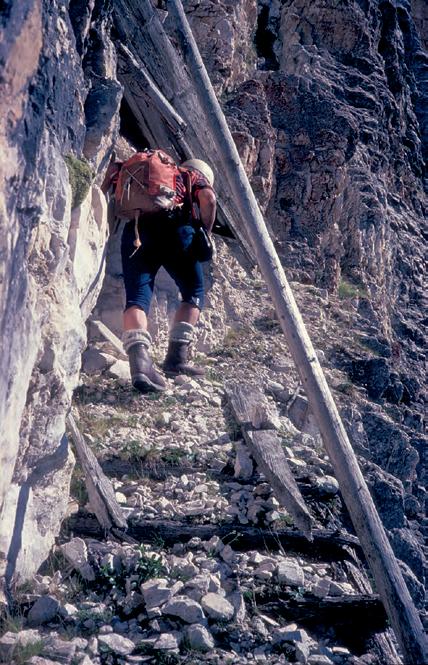
& trails.

Auch diese Aktion wurde von Seiten der italienischen Armee unterstützt. Der Alpini-Feldkochgehilfe beim Zubereiten des Abendessens. Anche questa iniziativa ebbe l’aiuto dell’esercito italiano: l’alpino aiuto cuoco da campo intento alla preparazione della cena. This action was also supported by the Italian Army. An Alpini field-kitchen assistant preparing dinner.
Non solo furono ripristinate tutte le più importanti vie di salita dalle valli al Monte Piana, ma furono collegate in un itinerario circolare le vie di accesso che allora portavano alle postazioni di entrambe le parti. Contemporaneamente iniziò anche lo sgombero e il ripristino delle trincee e dei camminamenti sepolti.

Der Nordbandweg. Il sentiero di collegamento nord. A trail along the north face of the North Crest.

Setzen
In the First World War the Italians repeatedly attempted to capture the Monte Piano and thus gain access to the Puster Valley, thereby blocking a major Austrian supply route. All attempts of breaking through were in vain. As a consequence the mountain became the site of the static trench warfare for 2 years.
The Friends of the Dolomites activities of the past few years affirmed the growing interest in the period 1914-1918. The idea of reconstructing historical sites from this era into open air museums was a direct result of this interest.


Not only were all of the major trails leading up the Monte Piano from the valley reconstructed, but also former front-line paths were also combined into a single circuit trail. Concurrent with the trail work, old trenches were excavated and restored.

nördliche Portal des Kaiserjägerstollens mit dem Wappen der Tiroler Kaiserjäger wird originalgetreu nach historischen Fotos rekonstruiert. L’accesso nord della galleria dei Kaiserjäger,
their original appearance by referring to archival photographs.







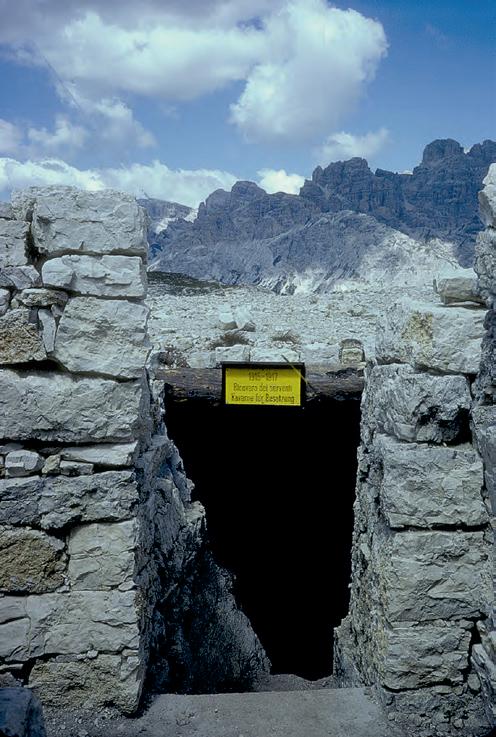


Gemeinsam gearbeitet, gemeinsam gefeiert. Si lavora assieme, si festeggia assieme. Having worked together, one could also celebrate together.



Der österreichische Armeekommandant General Spannocchi in Begleitung hoher italienischer Offiziere auf Besuch. Il generale d’armata austriaco Spannocchi, accompagnato da alti ufficiali italiani, in visita ai lavori.
The Austrian Army commander General Spannocchi accompanied by high-ranking officers of the Italian Army.

Schwere Materialtransporte wurden durch den Tragtierzug der italienischen Armee durchgeführt. Un reparto di muli dell’esercito italiano assicurò il trasporto di tutti i materiali pesanti.
Heavy construction materials and supplies were transported by pack animals provided by the Italian Army.



Neben der Capanna Carducci wehen die Nationalflaggen der freiwilligen Mitarbeiter. Accanto alla Capanna Carducci sventolano le bandiere nazionali dei collaboratori volontari. The national flags from the nations of all volunteers are seen flying along-side the Capanna Carducci hut.





Über dem Dreizinnen-Plateau erhebt sich der Toblinger Knoten (2617 m), im Krieg eine wichtige österreichisch-ungarische Beobachtungsstelle.
Ein kühn trassierter Frontklettersteig führte mit Hilfe von Holzleitern durch die senkrechte Nordwand zur Gipfelstellung, den der Zeitablauf schon seit Jahrzehnten unbegehbar gemacht hatte.
Sull’altopiano delle Tre Cime si alza la Torre di Toblino (2617 m), all’epoca importante osservatorio austro-ungarico.
Durante la guerra era stata tracciata sulla parete verticale nord un’audace via di salita che portava alla posizione di vetta, fornita di scale di legno, via che, con il passare del tempo, era diventata impraticabile.

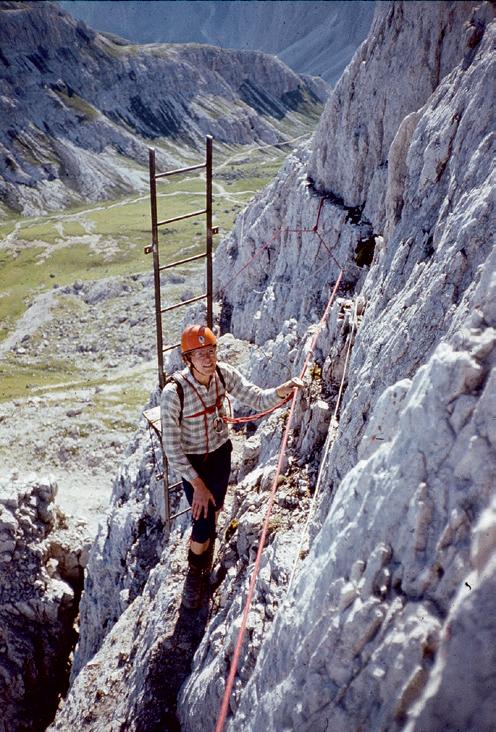


The Toblinger Knoten (2617 m), which dominates the Drei Zinnen Plateau, served as the location of an important Austrian observation post.
A bold and ingeniously laid climbing-trail led to its summit with the aid of vertical wooden ladders along the North Face. Deterioration of the ladders along this trail, in the course of time, had made it completely impassable for many decades.











Nach zehn Jahren Aktionsdurchführung in den Provinzen Südtirol, Trentino und Belluno entschloss sich Prof. Schaumann nun in Österreich tätig zu werden. Die Wahl fiel auf den Plöckenpass – das einzige Gebiet im heutigen Österreich, in dem noch viele Objekte der Jahre 1915-1917 vorhanden sind. Die Grundeigentümer, die Familie Gressel-Plöckner, stellte uns die Hausalm als Basislager zur Verfügung und gab ihr Einverständnis zur Errichtung des Freilichtmuseums auf ihrem Grund und Boden.
Dopo dieci anni di lavori portati a termine nelle province del Südtirol - Alto Adige, di Trento e di Belluno il professor Schaumann decise di lavorare in Austria. La scelta cadde sul settore del Passo di Monte Croce Carnico - l’unica zona dell’odierna Austria nella quale esistono ancora tante memorie degli anni 19151917.
La famiglia Gressel-Plöckner, proprietaria dei terreni, mise a nostra disposizione la vecchia malga come Campo Base e diede il proprio consenso all’allestimento del Museo all’Aperto sui terreni di loro proprietà.

Plöckenpass 1917. Passo di Monte Croce 1917. Plöckenpass 1917.
After 10 years of carrying out restoration projects in the provinces of South Tyrol, Trentino and Belluno, Prof. Schaumann decided to focus his attention on sites within Austria. The Plöcken Pass area was chosen as it was the only region in Austria that still had substantial objects and locations of historical interest from the war years 1915-1917.
The family Gressel-Plöckner are owners of the mountain and surrounding area of interest and kindly provided us with the „Hausalm“ for use as a base camp, as well as granting permission for the development of an Open Air Museum on their property.




Stimmungsbild beim Vereinssitz der Dolomitenfreunde in Wien vor der Verlegung in das neue Einsatzgebiet in Kärnten. Immagine della sede dell’associazione Amici delle Dolomiti a Vienna prima del trasferimento nel nuovo settore di lavoro in Carinzia. A picture taken during the process of relocating the Friends of the Dolomites Association headquarters from Vienna to the new work area in Carinthia.


Zwischen den ehemaligen Stall- und Wirtschaftsgebäuden wuchert das Unkraut und altes Gerümpel liegt herum. Tra la ex stalla e i fabbricati annessi erbaccia incolta e spazzatura ovunque. Rubbish, weeds and brush covered the ground between the former stables and out-buildings of the derelict farm.

Von den Straßenendpunkten ausgehend führten im Krieg Rollbahnen zu den Seilbahn-Talstationen. So war es naheliegend, im Basislager dieses Transportsystem mit Drehscheiben, Weichen und Rollbahnwagen zu zeigen. Al termine delle strade, durante la guerra, carrelli su binari portavano alle stazioni a valle delle teleferiche. Così è stato naturale ricostruire al Campo Base questo sistema di trasporto, con binari, dischi per girare i carrelli, scambi e carrelli. During the war narrow gauge rail-lines connected the end of the road to the valley stations of the supply cable cars. The base camp displays this former method of transport including turntables, a railway turn-out and a supply wagon, all in working order.





In jahrzehntelanger Sammeltätigkeit hatte Prof. Schaumann über 3000 Originalfotos, Skizzen und Karten über die alpine Südwestfront zusammengetragen. Zahlreiche Fundgegenstände lagerten in einem Keller. 1984 konnte der Verein in der Aula des Rathauses eine Ausstellung zur Dolomiten- und Kärntnerfront einrichten.

Dokumente, Lichtbilder und Exponate müssen gesichtet, geordnet und für die künftige museale Präsentation vorbereitet werden. Documenti, fotografie, e oggetti vengono valutati, ordinati e preparati per la futura presentazione museale. Documents, photographs and exhibits must be sorted, organized and prepared for future presentation in a museum.
In decine di anni di attività il professor Schaumann aveva raccolto più di 3.000 foto originali, schizzi e cartine del fronte italo-austriaco sulle montagne. Numerosi oggetti ritrovati negli scavi dormivano in una cantina. Nel 1984 l’associazione allestì una mostra sul fronte dolomitico-carinziano nelle sale all’ingresso del Municipio.

Einkleiden einer Figurine in die Uniform eines k.k. Gebirgsschützen. Allestimento dell’uniforme di un i. r. Gebirgsschützen su un manichino. Dressing a mannequin with the uniform of a k.k Gebirgsschütze.

After decades of collecting, Prof. Schaumann had gathered more than 3000 original photographs, sketches and maps pertaining to the alpine Southwestern Front. Many artefacts he had collected or found were stored in his cellar. In 1984 the Friends of the Dolomites were able to display a part of this collection in an exhibition of the Dolomite- and Carinthian Front in the foyer of the town hall.


Die Fotowände wurden in Eigenregie gebaut, Vitrinen von heimischen Firmen angefertigt. I pannelli per le fotografie vennero autocostruiti, i tavoli vetrina fornite da ditte locali. Photographs were mounted single-handedly on home-made display partitions and all the display cabinets were made by local companies.

Detailansichten der Ausstellung.
Bildwände und Vitrinen mussten in der Nebensaison abgebaut und zwischengelagert werden, wodurch zahlreiche Schäden entstanden. Immagini della mostra.
I pannelli e tavoli vetrina dovettero esser smontati alla fine dell’estate e la mostra riallestita all’inizio della stagione successiva, i danni furono numerosi. Details of the exhibition.
In the shoulder-seasons when the exhibition did not take place, the display partitions and cabinets needed to be dismantled and stored else where, resulting in considerable damage.
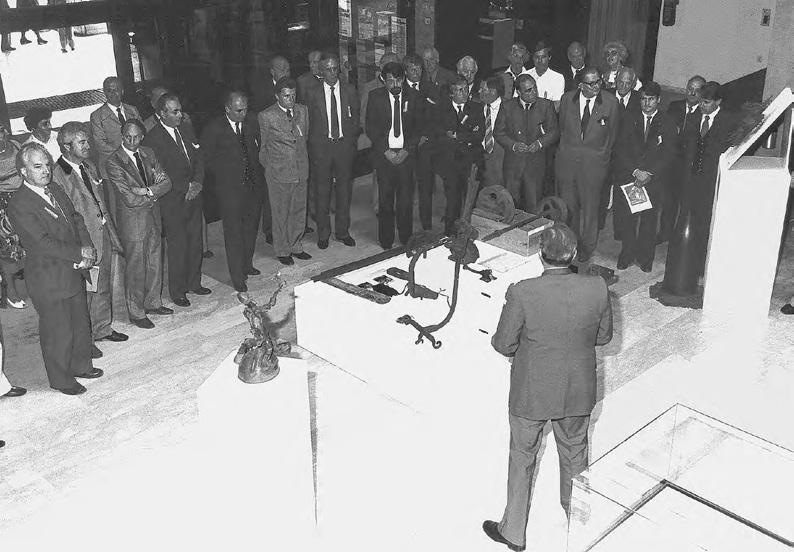

Reste von Kriegsseilbahnen. Parti di teleferiche militari. Remains of a war-time cable car.

Am 7.7.1984 wurde das „Plöckenmuseum“ im Rahmen einer Feier, an der ca. 2000 Personen teilnahmen (!) von Landeshauptmann L. Wagner eröffnet und erfreute sich bald zahlreicher Besucher.
Il 7 luglio 1984 il museo del Plöcken fu inaugurato dal capitano provinciale L. Wagner durante una festa alla quale presero parte circa 2.000 persone e ben presto ebbe numerosi visitatori. Approximately 2000 people partook in the official opening ceremony of the „Plöcken Museum“ which took place on 7 July 1984 and was presided over by the Governor of Carinthia: L. Wagner. Thereafter many visitors would be viewing and enjoying its’ interesting displays.





Nachdem das Land Kärnten 1990 in dankenswerter Weise die finanziellen Mittel und die Marktgemeinde Kötschach-Mauthen Räume im Rohbauteil des Rathauses zur Verfügung gestellt hatten, wurde es möglich, die Idee eines Museums der gesamten Südwestfront 1915-1918 vom Ortler bis zur Adria zu realisieren. Die gesamte Planung stammt von Prof. Schaumann, den Aufbau und das Einrichten übernahmen Freiwillige der DOLOMITENFREUNDE.





La regione Carinzia nel 1990 aveva messo a disposizione i mezzi finanziari e il Comune di Kötschach-Mauthen delle sale nella parte ancora da rifinire del palazzo municipale. Fu quindi possibile realizzare un museo comprendente tutto il fronte italo-austriaco dall’Ortles fino all’Adriatico.
Il professor Schaumann stese il progetto generale, l’esecuzione e l’allestimento furono opera dei volontari degli AMICI DELLE DOLOMITI.




The realization of the idea of a museum dedicated to the Southwest Front 1915-18 from the Ortler to Adriatic Sea was made possible in 1990 with the generous financial assistance provided by the Province of Carinthia, as well as the rooms which were made available for it within the Kötschach-Mauthen city hall.
The concept and overall plan originated from Prof. Schaumann, while the construction, arrangements and installations were accomplished with the assistance of the „FRIENDS OF THE DOLOMITES“ volunteers.



Das Buch zum Museum: Vom Ortler bis zur Adria – Der Gebirgskrieg zwischen Österreich-Ungarn und Italien
Il libro sul museo: Dall‘Ortles all‘Adriatico – La Guerra in Montagna fra Austria-Ungheria e Italia
The book about the museum: From the Ortler to the Adriatic Sea - The Mountain War between Austria-Hungary and Italy





Das Museum wurde 1992 eröffnet und erhielt mehrfache Auszeichnungen.
1996 wurde ihm der Kulturgüterschutz nach der Haager Konvention zuerkannt. Viele in- und ausländische hochrangige Persönlichkeiten seitens des Militärs sowie der Wirtschaft und Politik haben bisher bereits das Museum besucht.
Für seine unermüdliche Tätigkeit im Rahmen der „Friedenswege“ erhielt Prof. Schaumann mehrere Ehrenzeichen, 2002 wurde ihm die Ehrenbürgerschaft der Marktgemeinde Kötschach-Mauthen verliehen.






Il Museo fu inaugurato nel 1992 ed ottenne ben presto numerosi riconoscimenti.
Nel 1996 gli venne riconosciuto lo stato di bene culturale protetto secondo la convenzione dell’Aia. Finora hanno visitato il museo molte importanti personalità austriache e straniere, sia del mondo militare che di quello scientifico e politico.
Il professor Schaumann, per la sua instancabile attività nell’ambito delle Vie della Pace, ottenne parecchie onorificenze e nel 2002 gli venne conferita la cittadinanza onoraria di Kötschach-Mauthen.

The museum was established in 1992 and has received many awards.
In 1996 it was accredited with the Hague Convention’s Award for the Protection of Cultural Property. Many high-ranking members of the Austrian and other nation’s Armed Forces as well as important personalities of trade and industry have visited the museum.
Prof. Schaumann received numerous decorations and awards for his indefatigable activity in conjunction with the “Paths of Peace”. In 2002 the community of Kötschach- Mauthen made him an honorary citizen.














Seit 1983 arbeiten die DOLOMITENFREUNDE mit ihren Freiwilligen in diesem Gebiet. Sie haben es sich zur Aufgabe gemacht, Teile der sich in diesem Bereich befindlichen Verteidigungsstellungen zu restaurieren und sie so als Freilichtmuseum und Mahnmal gegen den Krieg für die Nachwelt zu erhalten.
Das Freilichtmuseum besteht aus den vier Sektoren:
• Sektor Plöckenhaus mit Hausalm
• Sektor Maschinengewehrnase
• Sektor Cellonstollen
• Sektor Kleiner Pal
Zentrale Ausgangspunkte für alle Sektoren sind die Parkplätze im Bereich des Plöckenhauses und im Bereich der Passhöhe.

Già nel 1983 i Amici delle Dolomiti sono presenti con i loro volontari in quest’area. Il compito che si sono posti è quello di ripristinare parti dalla posizioni difensive a suo tempo realizzate in questa zona, per trasformarle in un museo all’aperto e in un monumento contro la guerra, destinato a chi verrà dopo di noi.
Il Museo all’aperto è costituito da quattro settori:
• Settore Plöckenhaus e Malga Hausalm
• Settore Naso delle mitragliatrici
• Settore Galleria del Cellon
• Settore Pal Piccolo
Punti di partenza per tutti i percorsi sono i parcheggi situati vicino alla Plöckenhaus e quelli situati sul passo.

Since 1983, the Friends of the Dolomites and their volunteers have been working in the area of the Plöckenpass. They have set themselves the task of restoring parts of the defence emplacements there in order to preserve them as open air museum and, at the same time, as a memorial against war for future generations.
The open-air museum consists of four sectors:
• Plöckenhaus sector with Hausalm
• Machine gun nose sector
• Cellon tunnel sector
• Sector Kleiner Pal
The central starting points for all sectors are the parking spaces in the area of the Plöckenhaus and in the area of the pass.

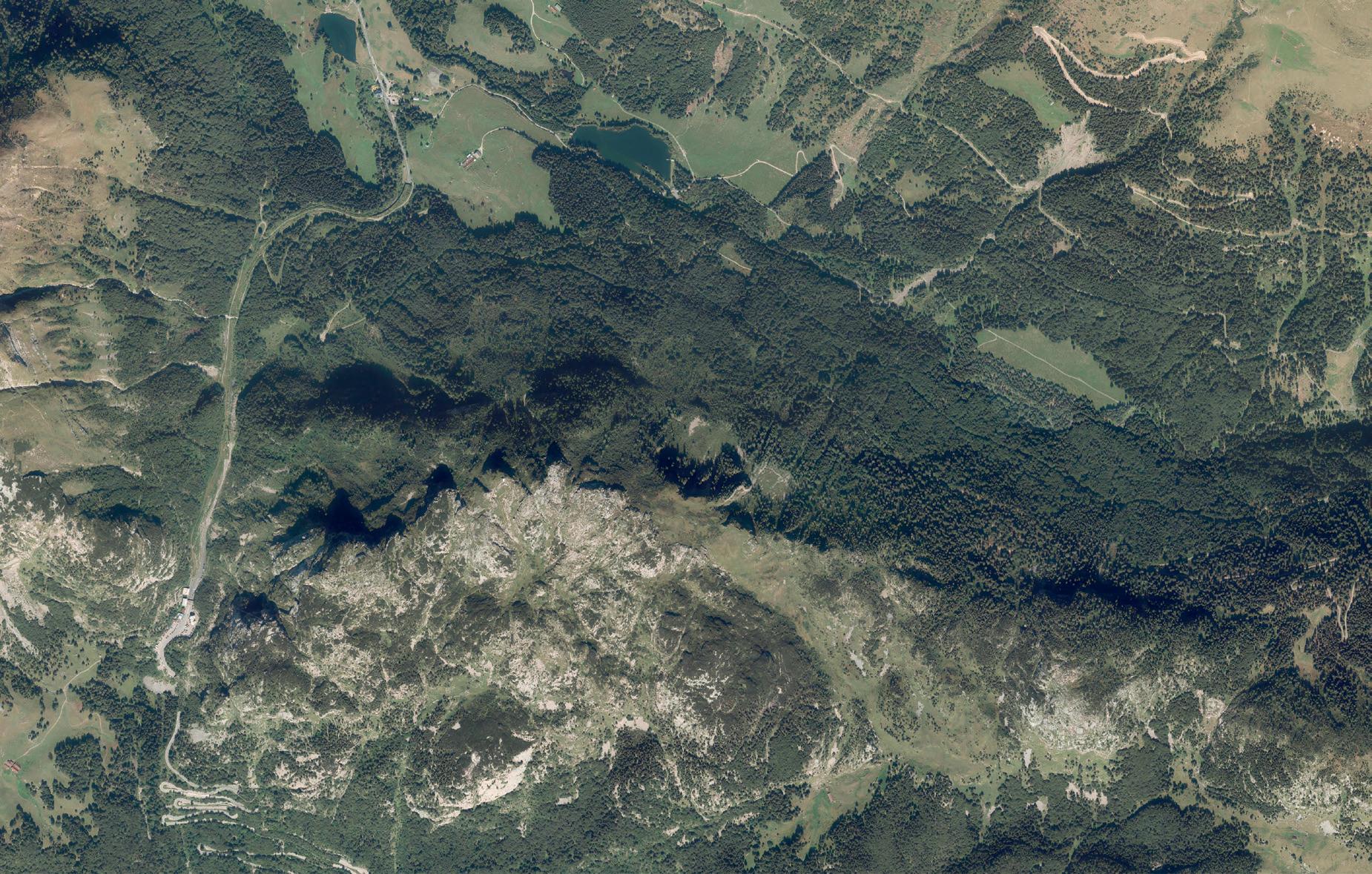











Der größte Sektor des Freilichtmuseums am Plöckenpass mit seinen zahlreichen restaurierten österreichisch-ungarischen und italienischen Stellungen befindet sich im Gipfelbereich des Kleinen Pal.
Il settore principale del museo all’aperto del Passo di Monte Croce Carnico, con le sue numerose postazioni austro-ungariche e italiane restaurate, si trova nella zona di vetta del Pal Piccolo.




The largest sector of the open-air museum on the Plöcken with its numerous restored Austro-Hungarian and Italian emplacements can be found in the summit area of the Kleiner Pal.




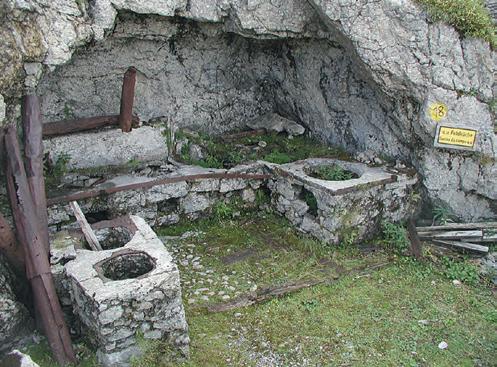






Die Maschinengewehrnase ist der am schnellsten erreichbare Sektor des Freilichtmuseums. Ausgangspunkt ist der österreichische Grenzparkplatz beim Windkraftwerk.
Die gesamte Anlage erhebt sich als entscheidende ehemalige österreichische Passsperre beherrschend östlich über die Passhöhe. Sie war für eine Rundumverteidigung konzipiert, um einen Durchbruch des Gegners bis zum Raum des Plöckenhauses zu verhindern. Ein Rundgang bietet die Möglichkeit die verschiedensten Formen des Weg- und Stellungsbaues sowie auch kurze Stollen und Kavernen zu besichtigen.
Il Naso delle mitragliatrici è il settore del Museo all‘aperto più facile da raggiungere. Il punto di partenza è il parcheggio dalla parte austriaca del confine, vicino al generatore eolico.
L‘intero complesso fortificato, sorto a est del passo e direttamente sovrastante lo stesso, faceva parte dello sbarramento militare dell‘epoca, costruito per impedire una penetrazione attraverso il passo da parte dell‘avversario, ed era concepito per una difesa su tutti i lati. Un itinerario ad anello permette di vedere diverse tipologie costruttive di percorsi e trincee, come pure di visitare piccole gallerie e caverne.
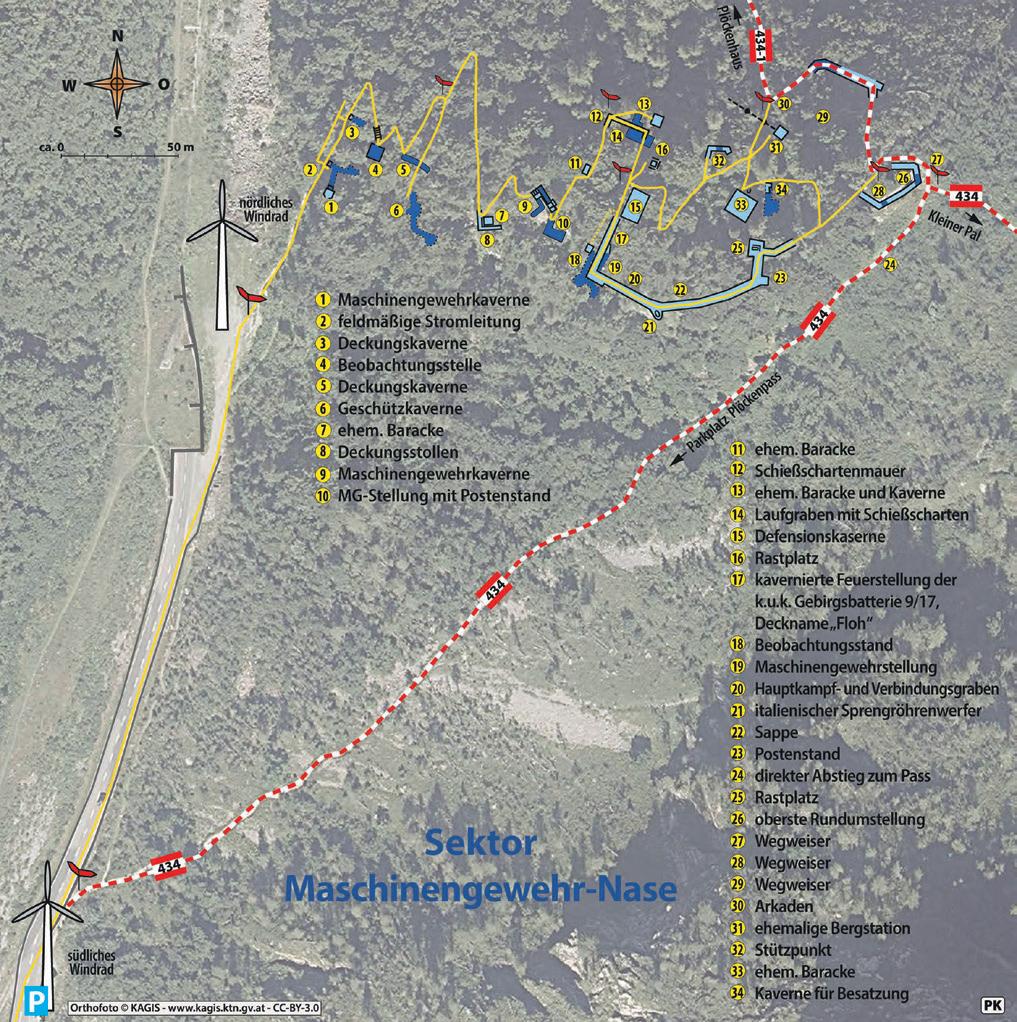
Übersichtsplan des Sektors • Piano generale del settore • General plan of the sector


The Machine Gun Nose (Maschinengewehr-Nase) is the sector of the open-air museum that is most easily accessible, starting from the parking lot near the wind power station on the Austrian side of the Plöckenpass-border.
The entire site, the former Austrian control barrier, towers above the pass slightly to the east. It was conceptualised to serve as defence in all directions in order to prevent the enemy from breaking through to the area of the Plöckenhaus. A circular route enables visitors to explore different forms of path- and emplacement construction as well as short tunnels and caverns.
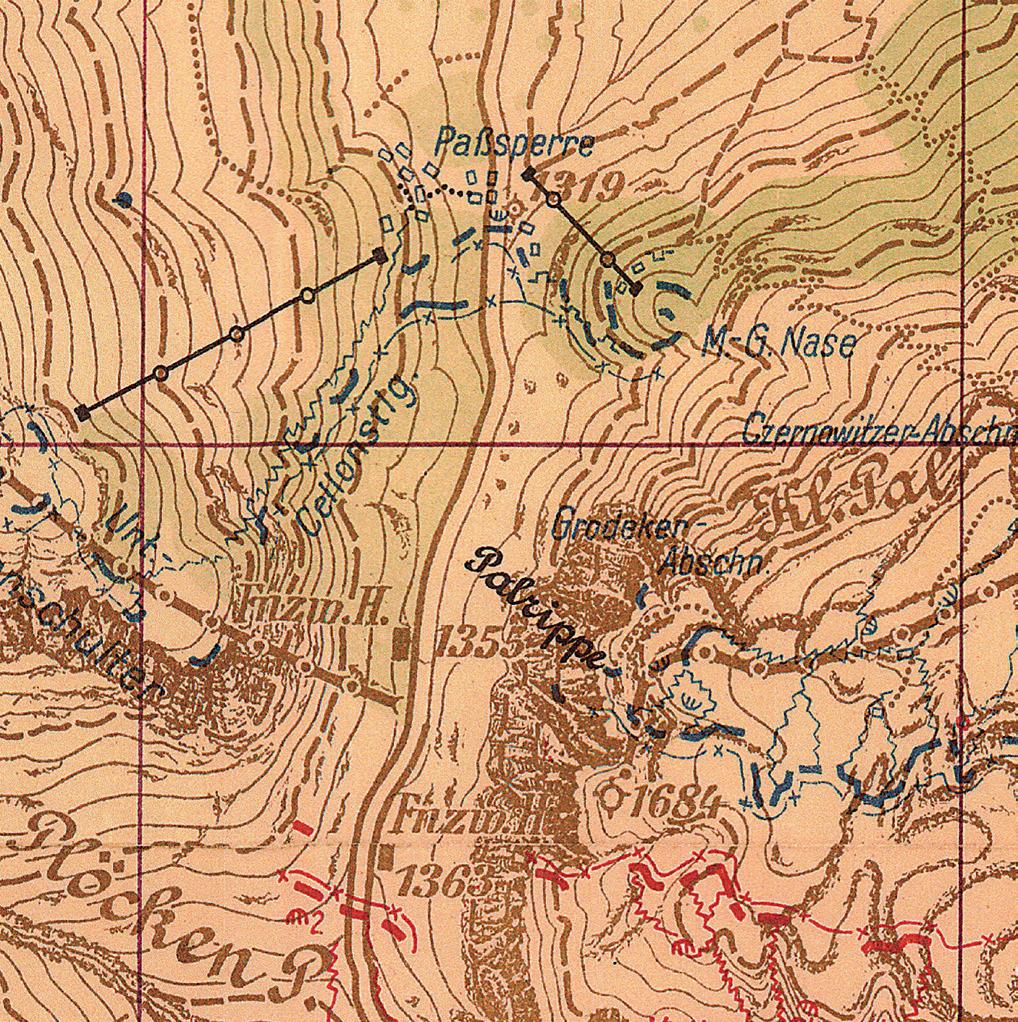
Übersichtsplan des Sektors 1917 • Piano generale del settore 1917 • General plan of the sector 1917
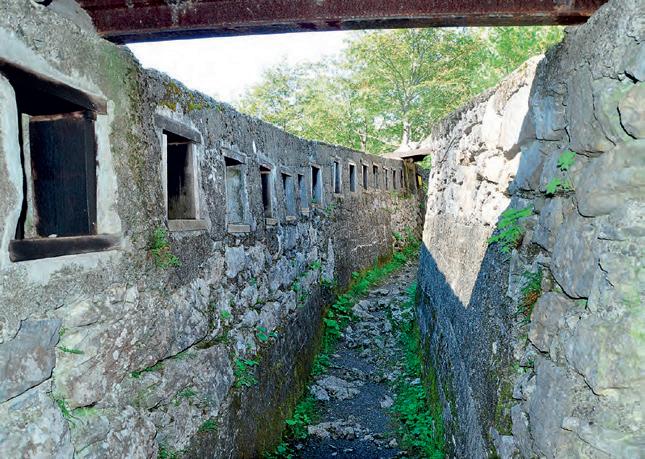






Einzig erhaltene „Defensionskaserne“ in Österreich. Solche Verteidigungsstützpunkte wurden seit der Zeit Napoleons an den wichtigsten Grenzübergängen errichtet, hatten aber nur geringen militärischen Wert. E‘ l’unica „caserma difensiva“ ancora presente in territorio austriaco. Questi capisaldi protetti erano stati originariamente costruiti durante le guerre napoleoniche nei punti di transito più importanti del confine, ma non avevano una grande rilevanza sul piano militare. The only preserved “defence barracks” in Austria. The construction of defence emplacements of this at important border crossings dates back to the times of Napoleon, but their military value was usually small.



Da die Versorgungswege zu den vordersten österreichischen Stellungen auf der Cellonschulter nach der Eroberung des Cellon von den Italienern eingesehen werden konnten, entschloss sich die k.u.k. Armeeführung, einen Stollen durch den Berg anzulegen, um so die Versorgung der Soldaten auf der Schulter zu sichern.
Unmittelbar vor der Grenze beginnt auf österreichischer Seite der zum Stolleneingang führende Steig. Der einzige unterirdische historische Klettersteig in Österreich mit 180 m Länge ist mit Trittklammern und durchlaufender Seilversicherung versehen. Der Höhenunterschied beträgt 117 m. Für die Begehung sind Klettersteigset, Stirnlampe und Steinschlaghelm dringend angeraten.
Poichè dopo la conquista del Cellon gli Italiani potevano osservare le linee di rifornimento delle posizioni austriache più avanzate, il comando austro-ungarico decise di realizzare una galleria che attraversando la montagna consentisse di garantire l’approvvigionamento delle truppe in linea. Il sentiero che conduce all’ingresso della galleria comincia subito dopo il confine, sul lato austriaco. Unica via ferrata sotterranea di interesse storico esistente in Austria, la galleria è ora nuovamente percorribile in tutti i suoi 180 metri di lunghezza, attrezzata con staffe metalliche e con un cavo di assicurazione continuo. Il dislivello è di 117 m.
A chi lo voglia percorrere si raccomanda caldamente di dotarsi di un’idonea imbragatura per ferrata, lampada frontale e casco.



Since the channels of supply to the Austrian positions on the Cellonschulter (Cellon shoulder) were observable by the Italians after they had conquered the Cellon, the Imperial and Royal army leadership decided to construct a tunnel leading upwards through the mountain in order to secure the line of supply to the shoulder.
The trail that leads to the entrance of the tunnel begins just before the border, on the Austrian side. The only subterranean via ferrata of 180 m in length is now equipped with rungs and secured with fixed rope throughout. Elevation gain: 117 m.
We advise to use a via ferrata set, headlamp and helmet for ascent through the Cellonstollen.









Die Hausalm oberhalb des Plöckenhauses kann über eine kurze Forststraße vorüber am Grünsee erreicht werden. Die Alm wurde 1915 zerstört und dann wieder aufgebaut. Sie dient heute dem Verein der DOLOMITENFREUNDE als Basislager. Hier nimmt die Materialseilbahn auf den Kleinen Pal ihren Anfang, deren technische Details teilweise auf das Jahr 1917 zurückgehen.
La malga, situata a monte della Plöckenhaus, può essere raggiunta attraverso una breve strada forestale che passa accanto al Grünsee/Lago Verde. Distrutta nel 1915, è stata poi ricostruita. Oggi essa costituisce il campo base dei DOLOMITENFREUNDE/AMICI DELLE DOLOMITI.
Qui è situata anche la stazione di valle della teleferica del Pal Piccolo, sulla quale si possono trovare informazioni risalenti in parte al 1917.







The Hausalm above the Plöckenhaus can be reached via a short stretch of gravel road, passing the lake Grünsee. The hut was destroyed in 1915 but was rebuilt later.
It now serves as the base camp for the FRIENDS OF THE DOLOMITES.
This is also the starting point of the cable car leading to the Kl. Pal, some of whose technical specifics date back to 1917.









Heute hat der Verein „DOLOMITENFREUNDE“ 360 Mitglieder aus Österreich, Deutschland, Italien, der Schweiz, Ungarn, Niederlande, Großbritannien und Belgien.
Der Verein „DOLOMITENFREUNDE“
• betreut das „Museum 1915-1918“ in KötschachMauthen,
• unterhält das „Freilichtmuseum Plöckenpass“,
• betreibt das „ARCHIV DOLOMITENFREUNDE“,
• bringt themenbezogene Publikationen heraus,
• unterrichtet seine Mitglieder mit der zweimal jährlich erscheinenden Vereinszeitschrift „DER DOLOMITENFREUND“ unterhält die Website „www.dolomitenfreunde.at“ mit Webshop und pflegt die Zusammenarbeit mit dem Österreichischen Bundesheer



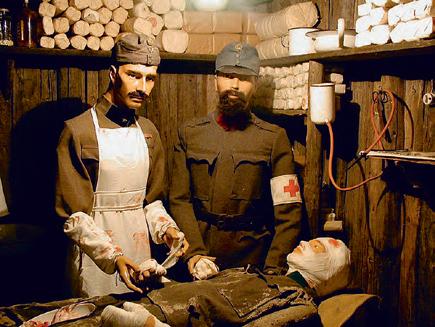
VEREINSZEITSCHRIFT

WEBSITE + SHOP
Oggi l’associazione “AMICI DELLE DOLOMITI” conta
360 membri provenienti da Austria, Germania, Italia, Svizzera, Olanda, Ungheria, Gran Bretagna e Belgio.
• L’associazione “AMICI DELLE DOLOMITI”
• cura il “Museo 1915-1918” a Kötschach-Mauthen,
• mantiene il “Museo all’aperto di Plöckenpass”,
• gestisce l’”ARCHIVIO DOLOMITENFREUNDE”,
• fa emergere pubblicazioni a tema,
• informa i suoi membri con la rivista dell’associazione “DER DOLOMITENFREUND”, che viene pubblicata due volte l’anno,
• mantiene il sito web “www.dolomitenfreunde.at” con webshop e
• mantiene la cooperazione con le forze armate austriache




VEREIN DOLOMITENFREUNDE


PUBLIKATIONEN






Today the association “FRIENDS OF THE DOLOMITES” has 360 members from Austria, Germany, Italy, Switzerland, Netherlands , Hungary, Great Britain and Belgium.
The association “FRIENDS OF THE DOLOMITES”
• curates the “Museum 1915-1918” in KötschachMauthen,
• operates the “Plöckenpass open-air museum”,
• operates the “ARCHIVE DOLOMITENFREUNDE”,
• publishes topic-related publications,
• informs its members with the association magazine “DER DOLOMITENFREUND”, which is published twice a year maintains the website “www.dolomitenfreunde.at” with webshop and maintains cooperation with the Austrian Armed Forces





ARCHIV DOLOMITENFREUNDE



ZUSAMMENARBEIT ÖSTERREICHISCHES BUNDESHEER






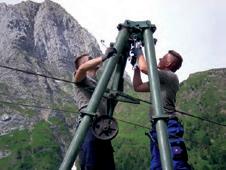





Seit 1983 unterstützt das Österreichische Bundesheer die Aktion„Friedenswege“ in Österreich, wo die materiellen und personellen Ressourcen des Vereins nicht ausreichen, durch Beistellung von schwerem Gerät, Hubschraubereinsatz und Entsendung von Spezialisten.
Ohne diese wertvolle Hilfe wäre vieles bei den Arbeiten auf den „Friedenswegen“ nicht möglich.

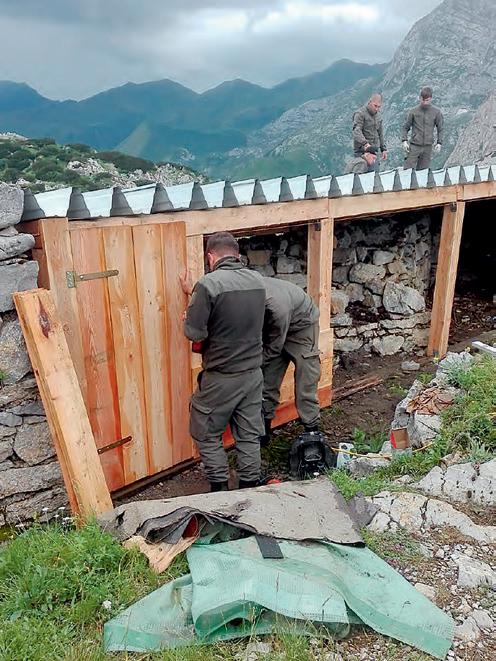
Dal 1983 l’esercito federale austriaco collabora nell’iniziativa delle Vie della Pace intervenendo quando le risorse materiali e personali dell’associazione non bastano, con macchinari pesanti, elicotteri e fornendo specialisti.
Senza questo valido aiuto molti dei lavori sulle “Vie della Pace” non sarebbero stati possibili.




The Austrian armed forces have been providing logistical (material and personnel) support for the „Paths of Peace“ operations since 1983, which would otherwise have been unattainable to the association. This support includes supplying heavy equipment and helicopters as well as specialists. Without this invaluable help, much of the work and projects for the „Paths of Peace“ would not be possible.
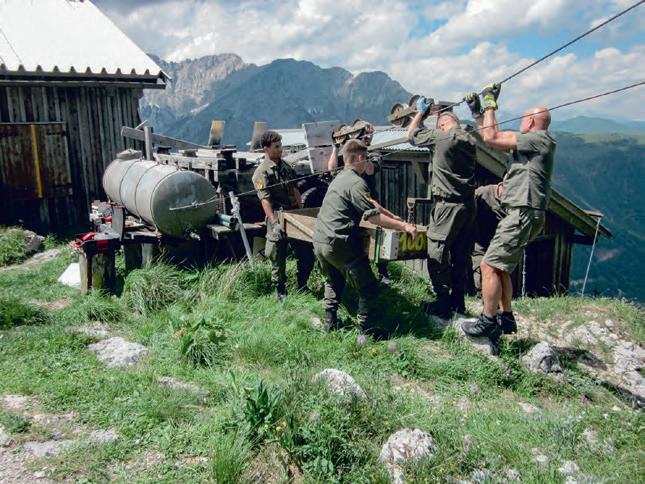


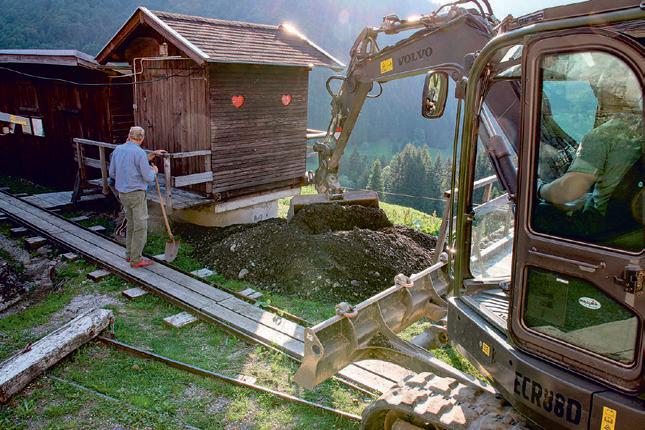








Besonders im unwegsamen Gelände einstiger Kriegsgebiete sind heute noch Funde von lebensgefährlichen Relikten möglich. Der Entminungsdienst ist seit 1983 im Plöckengebiet mit der Bergung, dem Abtransport und der Unschädlichmachung noch sprengkräftiger Kampfmittel aus dem Ersten Weltkrieg tätig. Beim Auffinden unbekannter sprengstoffverdächtiger Gegenstände verständigen Sie unverzüglich die nächstgelegene Sicherheitsdienststelle!
Für Laien gilt: „Hände weg – sonst sind sie weg!“


Servizio di sminamento: Specialmente sui terreni meno praticabili un tempozone di guerra, ancora oggi è possibile fare dei pericolosi ritrovamenti. Il servizio di sminamento opera dal 1983 nel settore del passo di Monte Croce Carnico individuando, spostando e neutralizzando ordigni potenzialmente ancora attivi della primaguerra mondiale. Di fronte a oggetti sconosciuti e probabilmente esplosivi avvisate senza indugio le autorità!
Per i profani vale l’avvertimento: ”via le mani – altrimenti se ne vanno via!”


Bomb Disposal Squads: Dangerous unexploded ordinance is occasionally still found in unfrequented locations. The bomb disposal squads have been actively involved in the extrication, defusing, removal and disposal of volatile wartime ordinance in the Plöcken Pass region since 1983.
Upon discovery of unknown live explosive ammunition it is imperative to notify the appropriate authorities in the region.
For the lay-person the motto is: “Keep your hand saway – otherwise you might lose them!”







»Wege, die einst Fronten trennten, sollen uns heute verbinden!«
Ursprünglich arbeiteten die Enkel und Urenkel der ehemaligen Kriegsgegner Österreich und Italien gemeinsam am Wegebau. Bis heute haben sich bereits Freiwillige aus über 20 Nationen in den Dienst der »Friedenswege« gestellt.
Die freiwilligen Helfer erhalten kostenlose Verpflegung, werden unfall- und haftpflichtversichert, kommen dafür aber für die Reisekosten selbst auf.
Wir freuen uns über jedes neue Mitglied und jeden neuen Mitarbeiter an den Friedenswegen!

»I sentieri che un tempo dividevano il fronte oggi devono unirci!«
All’inizio a lavorare assieme al ripristino di quei percorsi furono i nipoti e i pronipoti dei vecchi avversari di quella guerra.
Nel frattempo si sono posti al servizio delle “Vie della pace” volontari provenienti da oltre venti paesi. Durante i loro interventi, questi volontari ricevono vitto e alloggio gratuito e vengono coperti da un’assicurazione antinfortunistica e di responsabilità civile, dovendo provvedere in prima persona solo alle spese di viaggio.
Saremo lieti di dare il benvenuto ad ogni nuovo socio e collaboratore delle nostre iniziative!





»Paths that were once dividing front lines shall bring us together today!«
Originally, grandchildren and great-grandchildren of the former enemies Austria and Italy collaborated on the trail construction.
Today, our sites have seen numerous volunteers from more than 20 nations who all worked together on these ‘paths of peace’.
Volunteers receive full board and insurance, but they have to pay for their travel expenses themselves.
We are always happy to welcome new members or volunteers to work on the paths of peace!
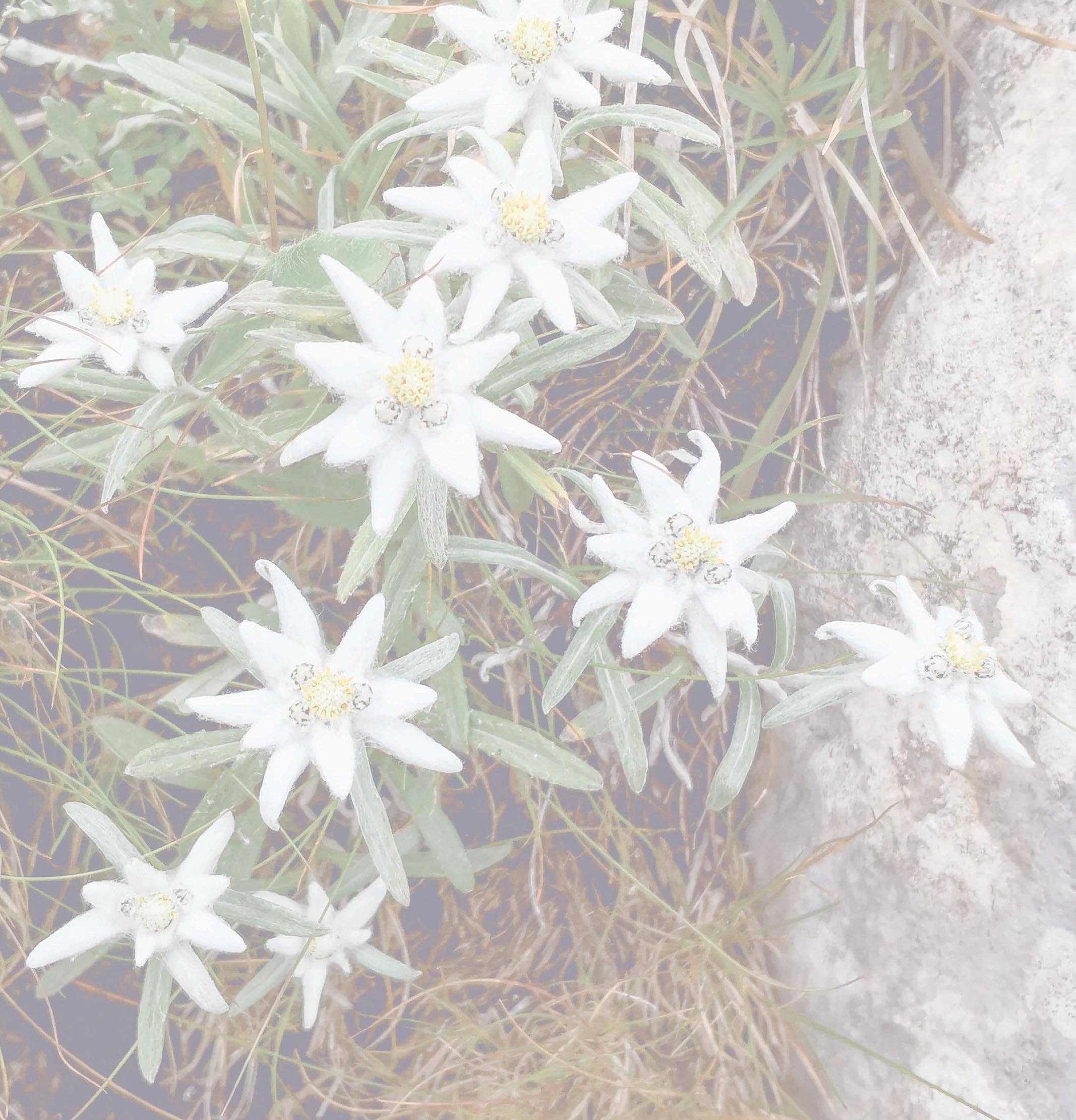


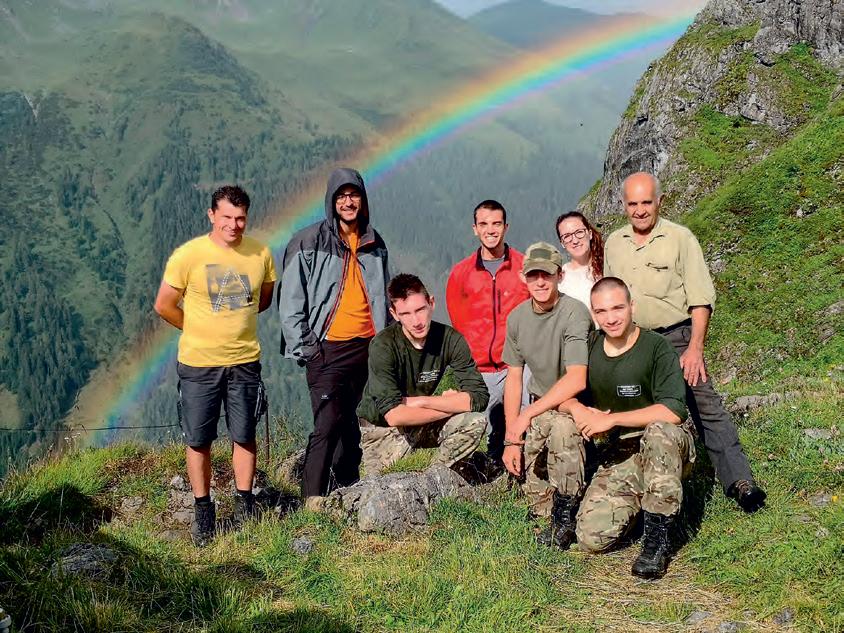


Wir brauchen Deine Hilfe! – Abbiamo bisogno del tuo aiuto! – We need your help!
Du hast
• Freude an der Bewegung in der Natur?
• Spaß an der Gemeinschaft im Gebirge?
• Lust auf sinnvolle freiwillige Arbeit?
• Fertigkeiten und Fähigkeiten, die Du einbringen möchtest?
• Interesse an Geschichte?
• eine oder zwei Wochen Zeit im Sommer?
Dann bist Du bei uns richtig!
Wir bieten
• kostenlosen Aufenthalt!
• Betreuung und Versicherungsschutz!
• naturnahe und nachhaltige Projekte!
• herrliche Locations im Gebirge!
• einfaches, aber intensives Leben!
• beste Kost von Profis!
• interessante Tätigkeiten für jede(n)!
Wir freuen uns auf Dich!
Melde Dich! – Mettiti in contatto! – Get in touch!
Tel.: +43 664 3045689 und +43 664 8725787 E-Mail: Office@dolomitenfreunde.at Website: www.dolomitenfreunde.at














